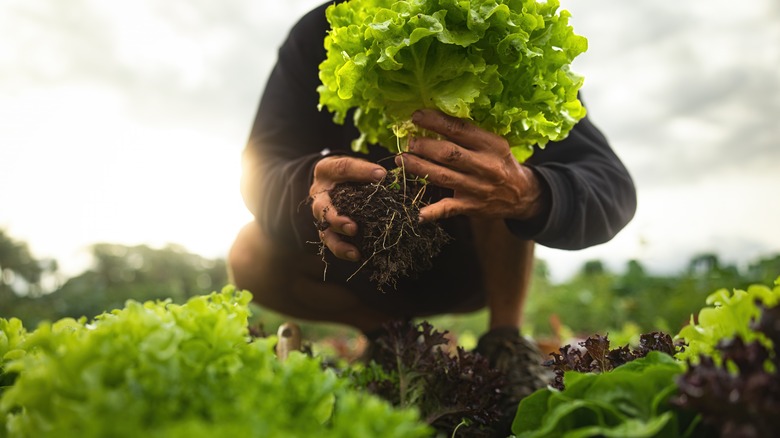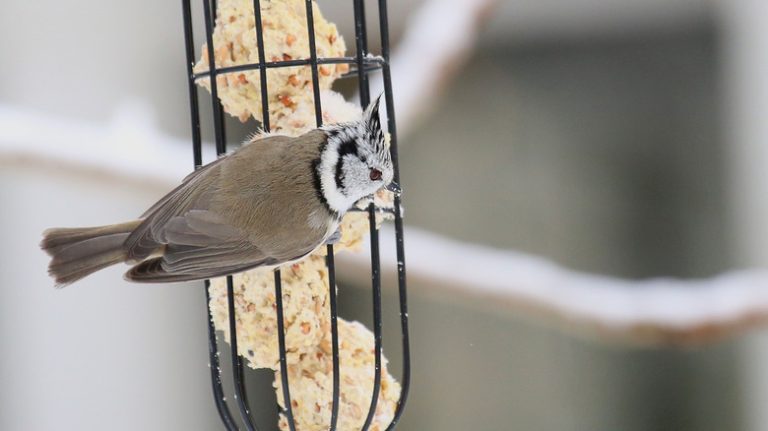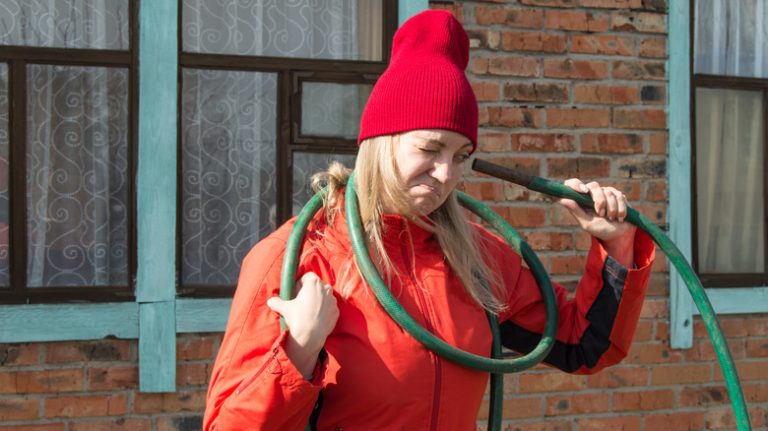Avid online shoppers know that it’s easier than ever before to order everyday necessities, gifts, and household items directly to your door. But sustainability-minded consumers may balk at the excess of single-use packaging that online shopping generates. The EPA estimated that containers and packaging constituted 28.1% of total municipal solid waste in 2024 — that’s 82.2 million tons of waste. This is a statistic that may very well have risen in the years since the pandemic pushed many consumers away from in-person shopping. Do you find yourself accruing more packaging than you can reasonably recycle? Or, maybe you live in a place where certain materials can’t be recycled. Then, upcycling may be your best bet to reduce your footprint when it comes to online shopping.
Thrifty gardeners are likely no strangers to upcycling. The garden is a great place to use materials that would otherwise be headed for a landfill, from upcycling wooden pallets to repurposing garden hoses. These savvy DIYs will help you save both money and the environment by turning old boxes, mailers, and packing supplies into free gardening solutions with just a little time and creativity.
Use packing paper as a mulch substitute
Upcycling packaging paper in the garden! ♻️ #garden #upcycle #recycle #fypシ #fyp
♬ original sound – JudyBaoGarden
Watch on TikTok
TikTok user @judybaogarden repurposes the shredded packing paper that often comes with fragile or boutique orders as a compostable mulch substitute. They first soak the paper in a bucket of water, then use kitchen tongs to fish it out and place it on top of plants. The paper will help retain moisture and insulate sprouts, and will eventually break down naturally.
As a mulch substitute, shredded packing paper could help control weeds and tidy up garden beds and planters. Soaking the paper before placing it reduces the chance that the shreds will blow away in addition to adding moisture to your seedlings. If you have lots of birds or squirrels near your garden, you may want to check back and replenish your paper mulch occasionally, as it’s also perfect for building nests.
Use packing peanuts for drainage
YouTuber Orchids & a Dutchy demonstrates how styrofoam packing peanuts can be used for container garden drainage. They place the peanuts at the bottom of a planter, where the waterproof styrofoam can facilitate drainage in a way similar to rocks or vermiculite. Using them for orchid drainage, this YouTuber warns against upcycling the wrong type of packing peanuts. Avoid the compostable, corn-starch variety as they will dissolve into goo when they come into contact with water, encouraging mold and bacteria growth. They also warn against using styrofoam peanuts that have been used to ship plants until it is certain that the plant is disease- and parasite-free since the peanuts could contaminate other plants.
While this DIYer uses packing peanuts specifically for orchids, this hack could be used for container gardens of any kind, indoor or outdoor. Try using up packing peanuts in herb or flower pots that need extra drainage in areas where there’s heavy rainfall. Just ensure that the packing peanuts are only used for drainage at the bottom of planters and are fully covered with soil. Because styrofoam isn’t biodegradable, it can be a hazard for wildlife if it’s not properly secured.
Start a new garden bed with cardboard
Save your cardboard and make a garden instead! #kitchengardenrevival #gardendesign #gardenideas #gardening101 #gardenproject #kitchengarden #gardener #sustainablegarden #nativeplant #nativegarden #wildlifehabitat
♬ original sound – Gardenary
Looking for a no-dig, no-hoe gardening method? This cardboard hack from @gardenary shows how you can start a new garden bed from scratch without raking or clearing a patch first. Just lay your broken-down cardboard boxes atop a section of lawn, add a layer of soil, and plant away. The cardboard will block grass and weeds from growing into your new bed before eventually breaking down into the earth below. Add mulch (or shredded packing paper!) for additional weed control if you like.
This method might work best for gardeners looking to start a new garden bed in an existing yard or lawn since the soil beneath the cardboard will eventually provide additional nutrients to the bed. If you’re in an urban setting, or hoping to section off some patio for growing, try using cardboard as the first layer in a raised garden bed and refreshing plants with new soil and compost over time.
Make your own planters
Plastic-free plant pots. Easy to make from cardboard. Plant them directly into the soil where the carboard will naturally decompose. This avoids distrubing the roots. #recycle #plasticfree #growyourown #gardeningtok #gardening #foryou #foryoupage #fyp #growyourown #greengardening
♬ Chandelier – Sia
Watch on TikTok
TikTok user @simonakerydgardener uses leftover cardboard boxes to help start seeds. They begin by soaking pieces of cardboard in water for 15 minutes. Then, they wrap the pliable cardboard around cans and bottles and fold it at the bottom in the shape of a planter. When the cardboard is still damp, they remove the cans/bottles and let it dry on its own. The free planters that result are perfect for transplanting starts into a larger bed without disturbing their fledgling roots. This DIY is a good substitute for other solutions, like yogurt cups, foam egg cartons, or plastic water bottles, for those hoping to keep their upcycling biodegradable.
Control weeds with cardboard
Cardboard box technique used in gardening to prevent weeds. #gardeninghacks #gardening #gardeningtips #preventingweeds #gardeningtiktok #cardboard #repurposing
♬ original sound – Susan
In a variation on the bed-starting cardboard DIY above, @susanfrugal illustrates how cardboard boxes can be used as a top layer rather than a bottom layer in an existing garden bed. They dig a hole for transplanting their zucchini starts, then cut a hole into a small piece of flat cardboard. They lay the cardboard over the hole in the ground, place their plant for transplant, and dampen the cardboard so it can be tamped down and covered in a final layer of soil and mulch. Just as it prevents weed growth at the bottom of garden beds, cardboard can limit weed growth closer to the soil surface and organize your transplants neatly. Try cutting the cardboard to size according to the area your seed packets recommend for best growth, then arrange it in rows to maximize the number of healthy plants you can fit in one plot.
Insulate a greenhouse with bubble wrap
Extend your growing season with bubble wrap in the greenhouse. #gardening #garden #plants #gardenproject #greenhouse
♬ Trap, hip hop, dark beat ♪(963369) – Ninja_Muzik_Tokyo
Watch on TikTok
Maybe your online shopping coincides with a cold holiday season when outdoor gardening is next to impossible. What better way to upcycle your packaging than lining a greenhouse or insulating an indoor plant setup? TikTok user @summit.business shows how they lined a greenhouse frame with layers of bubble wrap by using small clips to hold sheets in place.
Keep in mind, this TikTokker specifies that they use UV-treated bubble wrap for their greenhouse, which will degrade more slowly than ordinary bubble wrap as an insulation layer. If you’re concerned about UV damage, or, like most shoppers, don’t know the origin of the bubble wrap your shopping arrives with, this DIY might be best tested in a smaller, more contained setup. An indoor cloche or greenhouse cabinet could be a good start for such a bubble-wrap experiment.
Fill out oversize planters with packing material
#home #homehacks
♬ Luxury fashion (no vocals) – TimTaj
Watch on TikTok
Decorative planters by a doorway or garden path can be just the right touch to elevate an outdoor space. However, filling these statement-making containers can take a ton of costly soil, also making them pretty heavy. Here’s where an indoor decor hack could be adapted to an outdoor setting. As @decorsetupbymaria shows, packing material can be added to the bottom of oversized planters to fill out the pots.
While this TikToker tops the packing material with a faux plant and crafting moss, a crafty gardener could easily place a live plant in a smaller pot on top of the packing material platform and cover the edges with live moss or soil. You could even create a base of packing peanuts or bubble wrap, top it with cardboard using one of the DIY methods above, and then add a layer of soil to replicate a mini garden bed in a large planter.
Bulk up your compost
turn Amazon orders into fertilizer #garden #tiktokpartner #learnontiktok
♬ original sound – Epic Gardening
With all of the clever cardboard planter DIYs on YouTube and TikTok, it can be easy to forget that packing paper and mailers can be used in a more basic way around the garden: as browns when added to your home compost. Balance out the greens in your bin or pile by shredding paper packaging like TikTok user @epicgardening, who adds paper shreds from mailers. The thinly shredded paper will break down faster and help to control odor in your compost bin. Just be sure your ratio of greens to browns stays healthy to prevent excessive carbon or nitrogen in your garden.
Make your own seed packets from packing paper
Sometimes its just a matter of pausing and asking “what do i have that can do the same job”. Being resourceful is a skill i am seeking to continually develop. #selfsufficient #selfsufficiency #savingmoney #nzgardening #homesteadingnz #buildingahomestead #diyproject #gardeninghacks #easydiyprojects
♬ I Will Always Love You (Acoustic) – My Music 87
Watch on TikTok
Why buy premade seed envelopes when you could make your own? If you’re hoping to save seeds from your garden or reorganize your current seed collection, take a look at this seed packet tutorial from @livingonless.nz. This TikToker cuts newsprint to size and folds it origami-style into mini seed envelopes, then adds a sticker label to indicate which seeds are which. If your online shopping comes packed with newsprint or thin packing paper, simply sit it flat under a heavy book to straighten out the crinkles. Then, cut and fold for a free source of seed envelopes, saving waste from the landfill.
Protect outdoor plants from frost with bubble wrap
Stay tuned. If the tomatoes die … it was a waste of $15 on bubble wrap lmao RIP!!!
♬ original sound – McKenzie
Growing seasons can be unpredictable in areas that experience frost, and many a gardener has seen sprouts destroyed in early spring or late bloomers meet their ends as winter approaches. TikTok user @kenzpend runs into just such a problem when a cold snap threatens their otherwise healthy tomato plants. In an effort to save the many green tomatoes on the vine, the home gardener wraps trellises in bubble wrap and plastic sheeting and throws beach towels on top for extra warmth during the night. Since this DIY is implemented purely for insulation at night, there’s less to worry about here with UV damage and degradation. You could also use the thin plastic bags that clothing ships in, or padded bubble mailers, to further layer insulation for plants facing brief periods of frost.
Upcycle bubble mailers into hanging planters
#planthanger #galvanized #planthangerdiy #amazonprime #bubblemailerhack #trashtotreasure #repurposed #upcycle #upcyclediy #dollartreediy #craftideas
♬ So Good – Mauve
TikToker @itsdiydenise manages to turn one of Amazon’s infamous bubble mailers into a cute plant hanger with some creative upcycling. They split the mailer along one of its longer sides, hot glue the shorter side closed, and use silver, gray, and white paints to transform the plastic exterior into a faux galvanized planter. Then, they add brass grommets to the top of the mailer and thread nautical rope through them for hanging. If you’re replicating this DIY at home, using a grow bag or several small seedling pots inside the hanging planter could allow live plants to thrive in this smart upcycle. Who knew a bubble mailer could look this good?
Stabilize plants with plastic mail scraps
recycled garden ties #gardenhack #gardening #organicgardening #lifehack #lifehacks #plantips #tomatogardener #tomatogardening #tomatoes #tomatoplants #planties #gardentips #tipsandtricks #hack #recycle #reducereuserecycle #gogreen #recycleplasticwaste #zerowaste #treehugger #ecofreak #ItsGreatOutdoors #gardening #gardener #ilovemygarden #tipsfromgrandma #grandmaknowsbest #garden 2024 #CapCut
♬ Pieces (Solo Piano Version) – Danilo Stankovic
When components of your online order come separately packaged in thin plastic bags, it can be frustrating. But this packaging can take on a new life with this garden DIY from @bodybybacon89, who shows how the plastic can be converted into garden ties. They first fold a plastic bag lengthwise, then cut one-inch strips from the folded bag. They then cut the long, circular strips into ties, stabilize their tomato plants, and store the extra plastic strips on their garden fence for future use. The ties that result are waterproof and strong enough to keep vining plants upright. Excess plastic packaging can finally find a new use in areas where plastic bags can’t easily be recycled — and it can help your plants yield more fruits and veggies to boot.




